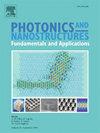Modulator and sensor based on in-plane mode weak coupling in borophene metamaterial
IF 2.5
3区 物理与天体物理
Q3 MATERIALS SCIENCE, MULTIDISCIPLINARY
Photonics and Nanostructures-Fundamentals and Applications
Pub Date : 2025-02-01
DOI:10.1016/j.photonics.2025.101366
引用次数: 0
Abstract
In this paper, tunable plasmon induced transparency-like (PIT-like) effect based on a borophene-based metamaterial structure is numerically investigated. The unit cell of the metamaterial is comprised of two borophene strips and a central borophene rectangle, both substructures can excite in-plane bright modes. We also discussed the influence of geometric parameters and external refractive index on PIT-like spectral lines. By adjusting the electron density of borophene, the PIT-like peak can be dynamically tuned. Particularly, by tuning the difference in electron densities between the two substructures, the width of the PIT-like window can be effectively modulated, and high-performance optical switching with modulation depth of is achieved. Furthermore, the proposed borophene plane metamaterial structure exhibits excellent significant slow light effect, a maximum group delay of is achieved, and it also demonstrates prominent sensing performance, the maximum refractive index sensitivity of and FOM of about are achieved. The results of this research have potential applications in optical switches, modulators, and slow-light devices.
基于硼罗芬超材料面内模弱耦合的调制器和传感器
本文对基于硼苯基超材料结构的可调谐等离子体诱导的类透明效应进行了数值研究。超材料的单元胞由两个硼罗芬条带和一个中央硼罗芬矩形组成,这两个子结构都可以激发平面内的亮模式。我们还讨论了几何参数和外部折射率对类pit谱线的影响。通过调节硼罗芬的电子密度,可以动态调节类pit峰。特别是,通过调整两个子结构之间的电子密度差,可以有效地调制类pit窗口的宽度,实现调制深度为85.1%的高性能光开关。此外,所提出的硼罗芬平面超材料结构具有优异的显著慢光效应,最大群延迟达到18.31fsis,并且具有优异的传感性能,最大折射率灵敏度为56.47THz/RIU, FOM约为51.29RIU−1。本研究结果在光开关、调制器和慢光器件中具有潜在的应用前景。
本文章由计算机程序翻译,如有差异,请以英文原文为准。
求助全文
约1分钟内获得全文
求助全文
来源期刊
CiteScore
5.00
自引率
3.70%
发文量
77
审稿时长
62 days
期刊介绍:
This journal establishes a dedicated channel for physicists, material scientists, chemists, engineers and computer scientists who are interested in photonics and nanostructures, and especially in research related to photonic crystals, photonic band gaps and metamaterials. The Journal sheds light on the latest developments in this growing field of science that will see the emergence of faster telecommunications and ultimately computers that use light instead of electrons to connect components.

 求助内容:
求助内容: 应助结果提醒方式:
应助结果提醒方式:


